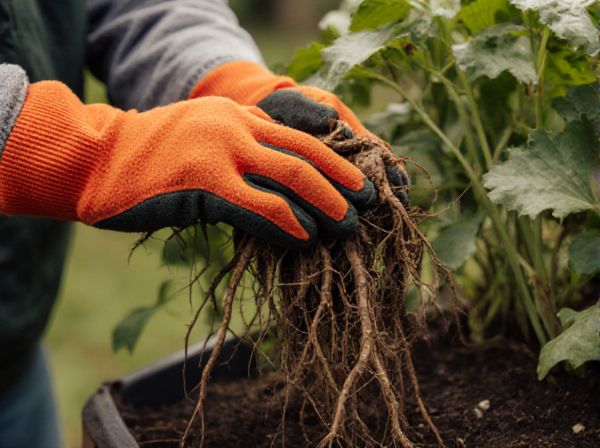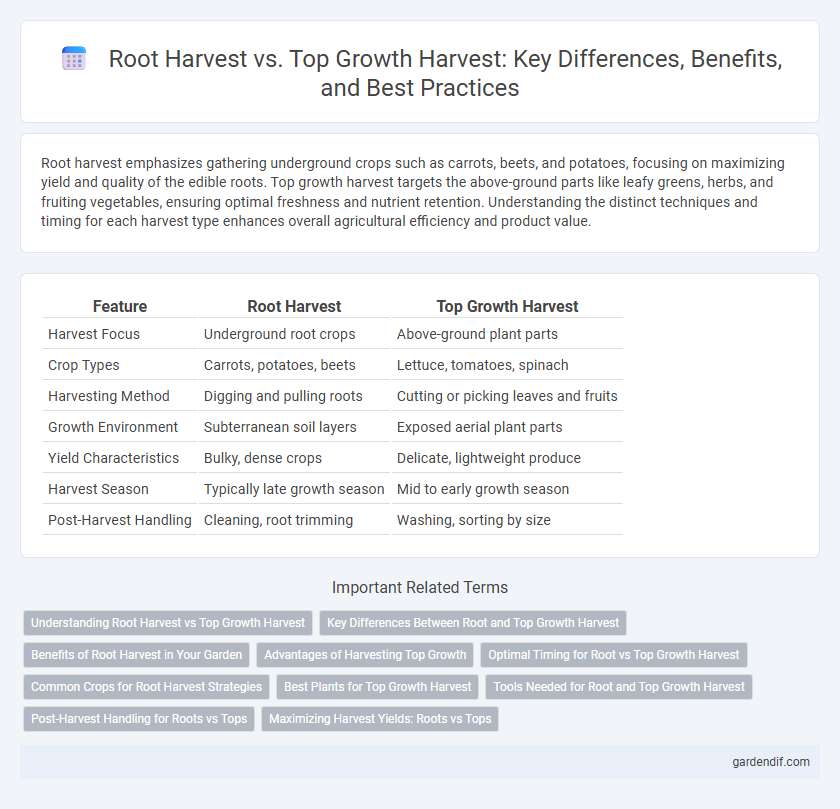
Root Harvest vs Top Growth Harvest Illustration
Root harvest emphasizes gathering underground crops such as carrots, beets, and potatoes, focusing on maximizing yield and quality of the edible roots. Top growth harvest targets the above-ground parts like leafy greens, herbs, and fruiting vegetables, ensuring optimal freshness and nutrient retention. Understanding the distinct techniques and timing for each harvest type enhances overall agricultural efficiency and product value.
Table of Comparison
| Feature | Root Harvest | Top Growth Harvest |
|---|---|---|
| Harvest Focus | Underground root crops | Above-ground plant parts |
| Crop Types | Carrots, potatoes, beets | Lettuce, tomatoes, spinach |
| Harvesting Method | Digging and pulling roots | Cutting or picking leaves and fruits |
| Growth Environment | Subterranean soil layers | Exposed aerial plant parts |
| Yield Characteristics | Bulky, dense crops | Delicate, lightweight produce |
| Harvest Season | Typically late growth season | Mid to early growth season |
| Post-Harvest Handling | Cleaning, root trimming | Washing, sorting by size |
Understanding Root Harvest vs Top Growth Harvest
Root harvest involves extracting the underground parts of plants, such as carrots, beets, and radishes, which are rich in nutrients like carbohydrates and minerals. Top growth harvest focuses on the above-ground portions, including leaves, stems, and flowers, often harvested for their vitamins, fibers, and essential oils. Understanding the distinction between root and top growth harvest is crucial for optimizing crop yield, timing, and nutritional value based on the specific plant species and desired agricultural outcome.
Key Differences Between Root and Top Growth Harvest
Root harvest focuses on extracting underground plant parts like carrots or beets, emphasizing soil quality and root development for nutrient-rich yields. Top growth harvest involves collecting above-ground biomass such as leaves, stems, and flowers, prioritizing photosynthesis efficiency and sunlight exposure for maximum vegetative growth. Key differences lie in harvest timing, plant part utilization, and the agricultural practices tailored to optimize either root depth or canopy density.
Benefits of Root Harvest in Your Garden
Root harvest enhances nutrient absorption by allowing gardeners to collect and replant healthy roots, promoting faster regrowth and increased plant resilience. This method improves soil structure and microbial activity, leading to better moisture retention and overall garden health. With root harvest, energy is concentrated in the root system, resulting in stronger, more vigorous plants compared to top growth harvest.
Advantages of Harvesting Top Growth
Harvesting top growth enhances regrowth speed and biomass production by preserving root systems intact, which leads to improved nutrient uptake and soil health. This method reduces plant stress and supports sustainable yield cycles, making it ideal for perennial crops. Top growth harvest also facilitates better pest and disease management by removing above-ground residues that harbor pathogens.
Optimal Timing for Root vs Top Growth Harvest
Optimal timing for root harvest occurs when the plant has allocated maximum nutrients to the roots, typically just before flowering or at the end of the vegetative stage, ensuring higher yield and quality of root crops like carrots and beets. In contrast, top growth harvest is best conducted when the above-ground parts reach peak biomass and nutrient density, often during full flowering or early seed formation, which is critical for leafy vegetables and herbs. Understanding plant development stages and specific crop physiology is essential to determine whether root or top growth harvest will maximize nutritional and economic value.
Common Crops for Root Harvest Strategies
Root harvest strategies primarily target crops such as carrots, beets, radishes, and turnips, which develop edible underground structures rich in nutrients. These root vegetables require careful soil management to maximize yield and quality during harvest, emphasizing minimal damage to the roots for marketability. Root harvest techniques often involve specialized machinery or manual methods designed to extract the crops without bruising or breaking the delicate root systems.
Best Plants for Top Growth Harvest
Root harvest focuses on plants like carrots, beets, and radishes, prized for their nutrient-dense underground parts. In contrast, top growth harvest targets leafy greens and herbs such as lettuce, spinach, kale, and basil, which provide abundant above-ground yields and quicker regrowth cycles. These plants optimize continuous harvesting, delivering fresh, nutrient-rich foliage ideal for salads, garnishes, and culinary uses.
Tools Needed for Root and Top Growth Harvest
Root harvest requires specialized tools such as digging forks, spades, and soil probes to efficiently extract underground crops like carrots, potatoes, and beets without damaging them. Top growth harvest depends on pruning shears, harvesting knives, and pole pruners to cut leafy greens, fruits, or stems precisely and maintain plant health. Proper selection of these tools enhances harvest quality and reduces crop loss during both root and top growth collection processes.
Post-Harvest Handling for Roots vs Tops
Root harvest requires careful post-harvest handling to prevent damage and decay, involving immediate cleaning, cooling, and proper storage to maintain moisture and firmness. Top growth harvest demands gentle handling to avoid bruising and rapid transport to cold storage to preserve freshness and nutrient content. Both methods benefit from minimizing exposure to heat and light to extend shelf life and market quality.
Maximizing Harvest Yields: Roots vs Tops
Maximizing harvest yields requires understanding the distinct value of root versus top growth harvests, as root crops like carrots and beets store vital nutrients underground while top growth harvests, such as leafy greens and herbs, offer faster turnover and higher vitamin content. Root harvests often yield greater biomass per plant and longer storage life, making them ideal for sustained supply chains. Prioritizing cultivation techniques that enhance root development or promote lush top foliage depends on crop goals and market demand, optimizing overall productivity and profitability.
Root Harvest vs Top Growth Harvest Infographic

 gardendif.com
gardendif.com